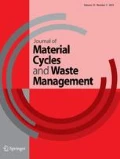Abstract
Appropriate treatment of asbestos waste is a significant problem. In Japan, inertization of asbestos-containing waste by novel techniques approved by the Ministry of the Environment is now promoted. A quantitative method of testing with high sensitivity to the asbestos levels present in the inertization products is required for the approval process, but many testing methods are only qualitative. Thus, we have developed an evaluation method for asbestos in inertized products, consisting of the extraction of fibers from inertized products and determination of fiber number concentration by transmission electron microscopy. We adopted this testing method to evaluate thermally treated asbestos. It was found that fiber number concentrations of thermally treated asbestos decreased with increased treatment temperature, and were below the environmental level (102 Mf/g) at more than 1000 °C for chrysotile and crocidolite and more than 1400 °C for amosite and other amphibole forms of asbestos.








Similar content being viewed by others
References
Morinaga K (ed) (2008) Exposure to asbestos and diseases caused by asbestos (in Japanese). Sanshin Tosho, Tokyo
World Health Organization (1986) Asbestos and other natural mineral fibers; environmental health criteria 53. World Health Organization, Geneva
Dodson RF, Hammar SP (eds) (2006) Asbestos: risk assessment, epidemiology, and health effects. CRC Press, Boca Raton
Japan Asbestos Association (2003) Estimation of emission of asbestos containing construction wastes (in Japanese)
Yoshida H, Hata Y (2006) Management of asbestos containing wastes (in Japanese). Mater Cycles Waste Manage Res 17:255–262
Japan Industrial Standard (2014) Determination of asbestos in building material products—Part 3: quantitative analysis of containing asbestos by X-ray diffraction method. JIS A 1481-3
International Organization for Standardization (2014) Air quality—bulk materials—Part 2: quantitative determination of asbestos by gravimetric and microscopical methods. ISO 22262-2. International Organization for Standardization (ISO), Geneva, Switzerland
Rickards AL (1973) Estimation of submicrogram quantities of chrysotile asbestos by electron microscopy. Anal Chem 45:809–811
Burdett GJ, Rood AP (1983) Membrane-filter, direct-transfer technique for the analysis of asbestos fibers or other inorganic particles by transmission electron microscopy. Environ Sci Technol 17:643–648
International Organization for Standardization (1995) Ambient air—determination of asbestos fibres—direct transfer transmission electron microscopy method. ISO 10312. International Organization for Standardization (ISO), Geneva, Switzerland
Yamamoto T, Kida A, Noma Y, Terazono A, Sakai S (2014) Development of a testing method for asbestos fibers in treated materials of asbestos containing wastes by transmission electron microscopy. Waste Manag 34:536–541
Jeyaratnam M, West NG (1994) A study of heat-degraded chrysotile, amosite, and crocidolite by X-ray diffraction. Ann Occup Hyg 38:137–148
Pitt R (1988) Asbestos as an urban area pollutant. J Water Pollut Control Fed 60:1993–2001
Acknowledgements
The authors thank the Ministry of the Environment for financial support through waste treatment research Grants K1804, K1947 and K2054.
Author information
Authors and Affiliations
Corresponding author
Electronic supplementary material
Below is the link to the electronic supplementary material.
Rights and permissions
About this article
Cite this article
Yamamoto, T., Kida, A., Noma, Y. et al. Evaluation of thermally treated asbestos based on fiber number concentration determined by transmission electron microscopy. J Mater Cycles Waste Manag 20, 214–222 (2018). https://doi.org/10.1007/s10163-016-0564-2
Received:
Accepted:
Published:
Issue Date:
DOI: https://doi.org/10.1007/s10163-016-0564-2




